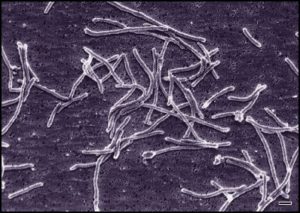The Polymerase Chain Reaction Was Made faster by an Enzyme of Thermus Aquaticus.

Image: Thermus aquaticus, Creative Commons
From 1965 through 1975, Dr. Thomas Brock conducted field and laboratory research on thermophilic microorganisms in Yellowstone National Park, funded by a grant from the National Science Foundation. From a sample of pink bacteria collected from Mushroom Spring, Brock and undergraduate student Hudson Freeze isolated an organism thriving at 70̊C (160̊F) which they named Thermus aquaticus. The ability of T. aquaticus to tolerate high heat would, 20 years later, make possible the invention of a procedure called polymerase chain reaction. PCR utilizes an enzyme in T. aquaticus, now known as Taq polymerase, to speed up DNA replication. The process, invented by Kary Mullis, won a Nobel Prize.[6]
Source: Wikipedia on biography of Thomas Brock.
In the very earliest days of the polymerase chain reaction amplifications were carried out using water baths and lab timers and the best available DNA polymerases of the time, Klenow or T4 DNA polymerase. During the essential DNA denaturation step, 94 degrees Centigrade or 95 degrees Centigrade, for up to a minute, the DNA target was rendered single stranded. It also destroyed the polymerase each time so that fresh enzyme had to be added just after each denaturation step. Since the average duration of a PCR cycle is about five minutes, this became a very labor-intensive bottleneck. The answer to this problem was, as are all good solutions, blindingly simple. There exists in nature organisms that are perfectly happy at very high temperatures. Such organisms, called thermophiles or “heat loving”, were defined by Brock as organisms that live all or part of their life cycle above the so-called thermophile boundary which is set at 50-60 degrees Centigrade.[5].
Source: This article, by Integrated DNA Technologies.
The above article is a very reader-friendly, detailed, description of the polymerase chain reaction and the important role in that reaction played by the Thermus Aquaticus thermophilic bacteria, in furthering research on DNA. The technology has been applied to diagnosis of HIV, and more recently, the Ebola virus.
The details of the Polymerase Chain Reaction may be gleaned from such sources as the above article.
Also, the Cornell article below will be useful to students wishing to learn the Polymerase Chain Reaction process. Find the full Cornell paper here, which begins as follows (we note that instead of “Thermus Aquaticus” the Cornell article uses the name “Thermus Aquiphilus”):
Most DNA analysis situations require fairly large amounts of DNA. Usually the amount in a few cells is not enough to fully analyze. A method called the polymerase chain reaction (PCR) has been developed to amplify the amount of DNA in a sample.
Background
Since DNA polymerase is an enzyme it will denature (lose its natural qualities) under high heat situations. A special form of DNA polymerase was isolated from Thermus aquiphilus, a thermophilic (heat loving) bacterium found in hot springs in Yellowstone National Park. This DNA [enzyme] polymerase, Taq (“T” for Thermus, “aq” for Aquiphilus) polymerase, does not denature under high heat situations and is used in PCR.
Basically, the Cornell paper above is a teaching paper, based on the premise that “The polymerase chain reaction (PCR) is an important technique for biology students to learn.”
This article has provided an overview of a rich body of science pertaining to extremophiles. We’ve tried to show some of the breadth of information an interested student could pursue.



